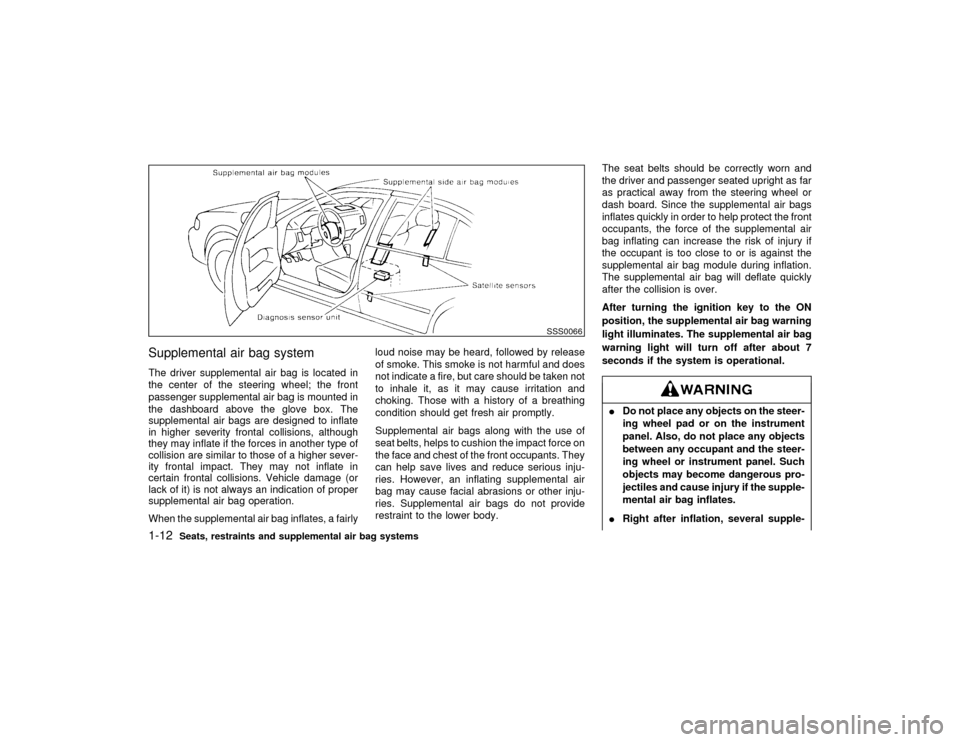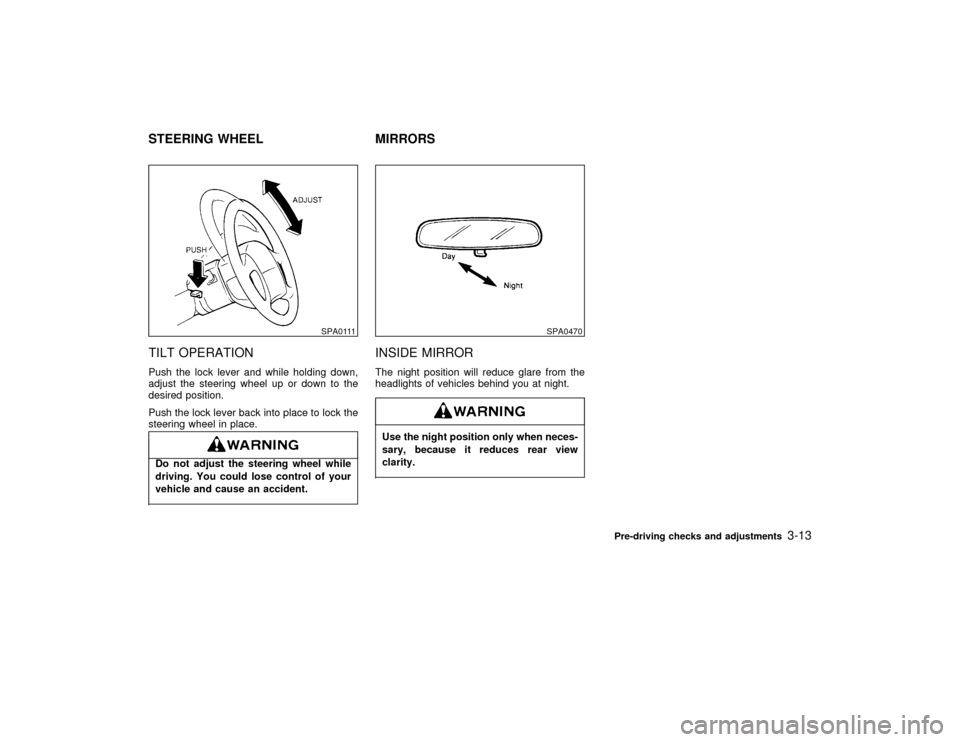1998 NISSAN MAXIMA steering wheel
[x] Cancel search: steering wheelPage 14 of 231

PRECAUTIONS ON
SUPPLEMENTAL RESTRAINT
SYSTEMThis Supplemental Restraint System (SRS)
section contains important information con-
cerning the driver and passenger supplemen-
tal air bags and supplemental side air bags.
Supplemental air bag system:This system
can help cushion the impact force to the face
and chest of the driver and front passenger in
certain frontal collisions.
Supplemental side air bag system (if so
equipped):This system can help cushion the
impact force to the chest area of the driver and
front passenger in certain side impact colli-
sions. The supplemental side air bag is de-
signed to inflate on the side where the vehicle
is impacted.
These supplemental restraint systems are de-
signed tosupplementthe crash protection
provided by the driver and front passenger
seat belts and arenot a substitutefor them.
Seat belts should always be correctly worn
and the driver and front passenger seated a
suitable distance away from the steering
wheel, instrument panel and front door finish-
ers. (See ªSeat beltsº later in this section for
instructions and precautions on seat belt us-
age.)After turning the ignition key to the ON
position, the supplemental air bag warning
light illuminates. The supplemental air bag
warning light will turn off after about 7
seconds if the system is operational.SUPPLEMENTAL RESTRAINT
SYSTEM
Seats, restraints and supplemental air bag systems
1-7
Z
01.1.31/A32-D
X
Page 16 of 231

IKeep hands on the outside of the
steering wheel. Placing them inside
the steering wheel rim could increase
the risk that they are injured when the
supplemental air bag inflates.
SSS0098
SSS0006SSS0007
Seats, restraints and supplemental air bag systems
1-9
Z
01.1.31/A32-D
X
Page 19 of 231

Supplemental air bag systemThe driver supplemental air bag is located in
the center of the steering wheel; the front
passenger supplemental air bag is mounted in
the dashboard above the glove box. The
supplemental air bags are designed to inflate
in higher severity frontal collisions, although
they may inflate if the forces in another type of
collision are similar to those of a higher sever-
ity frontal impact. They may not inflate in
certain frontal collisions. Vehicle damage (or
lack of it) is not always an indication of proper
supplemental air bag operation.
When the supplemental air bag inflates, a fairlyloud noise may be heard, followed by release
of smoke. This smoke is not harmful and does
not indicate a fire, but care should be taken not
to inhale it, as it may cause irritation and
choking. Those with a history of a breathing
condition should get fresh air promptly.
Supplemental air bags along with the use of
seat belts, helps to cushion the impact force on
the face and chest of the front occupants. They
can help save lives and reduce serious inju-
ries. However, an inflating supplemental air
bag may cause facial abrasions or other inju-
ries. Supplemental air bags do not provide
restraint to the lower body.The seat belts should be correctly worn and
the driver and passenger seated upright as far
as practical away from the steering wheel or
dash board. Since the supplemental air bags
inflates quickly in order to help protect the front
occupants, the force of the supplemental air
bag inflating can increase the risk of injury if
the occupant is too close to or is against the
supplemental air bag module during inflation.
The supplemental air bag will deflate quickly
after the collision is over.
After turning the ignition key to the ON
position, the supplemental air bag warning
light illuminates. The supplemental air bag
warning light will turn off after about 7
seconds if the system is operational.
IDo not place any objects on the steer-
ing wheel pad or on the instrument
panel. Also, do not place any objects
between any occupant and the steer-
ing wheel or instrument panel. Such
objects may become dangerous pro-
jectiles and cause injury if the supple-
mental air bag inflates.
IRight after inflation, several supple-
SSS0066
1-12
Seats, restraints and supplemental air bag systems
Z
01.1.31/A32-D
X
Page 20 of 231

mental air bag system components
will be hot. Do not touch them; you
may severely burn yourself.
INo unauthorized changes should be
made to any components or wiring of
the supplemental air bag system.
This is to prevent accidental inflation
of the supplemental air bag or dam-
age to the supplemental air bag sys-
tem.
IDo not make unauthorized changes
to your vehicle's electrical system,
suspension system or front end
structure. This could affect proper
operation of the supplemental air bag
system.
ITampering with the supplemental air
bag system may result in serious
personal injury. Tampering includes
changes to the steering wheel and
the instrument panel assembly by
placing material over the steering
wheel pad, above the dashboard, or
by installing additional trim material
around the supplemental air bag sys-
tem.IWork around and on the supplemen-
tal air bag system should be done by
an authorized NISSAN dealer. Instal-
lation of electrical equipment should
also be done by an authorized
NISSAN dealer. The SRS wiring har-
nesses* should not be modified or
disconnected. Unauthorized electri-
cal test equipment and probing de-
vices should not be used on the
supplemental air bag system.
* The SRS wiring harnesses are cov-
ered with yellow insulation either just
before the harness connectors or
over the complete harness for easy
identification.
When selling your vehicle, we request that you
inform the buyer about the supplemental air
bag system and guide the buyer to the appro-
priate sections in this Owner's Manual.Supplemental side air bag systemThe supplemental side air bags are located in
the outside of the seatback of the front seats.
The supplemental side air bag (on the driver or
front passenger seat) is designed to inflate in
higher severity side collisions, although it may
inflate if the forces in another type of collisionare similar to those of a higher severity side
impact. It is designed to inflate on the side
where the vehicle is impacted. It may not
inflate in certain side collisions. Vehicle dam-
age (or lack of it) is not always an indication of
proper supplemental side air bag operation.
When the supplemental side air bag inflates, a
fairly loud noise may be heard, followed by
release of smoke. This smoke is not harmful
and does not indicate a fire, but care should be
taken not to inhale it, as it may cause irritation
and choking. Those with a history of a breath-
ing condition should get fresh air promptly.
Supplemental side air bags along with the use
of seat belts, help to cushion the impact force
on the chest of the front occupants. They can
help save lives and reduce serious injuries.
However, an inflating supplemental side air
bag may cause abrasions or other injuries.
The seat belts should be correctly worn and
the driver and passenger seated upright as far
as practical away from the supplemental side
air bag. Since the supplemental side air bag
inflates quickly in order to help protect the front
occupants, the force of the supplemental side
air bag inflating can increase the risk of injury
if the occupant is too close to or is against the
supplemental side air bag module during infla-
tion. The supplemental side air bag will deflate
quickly after the collision is over.
Seats, restraints and supplemental air bag systems
1-13
Z
01.1.31/A32-D
X
Page 47 of 231

Windshield wiper/washer switch (P.2-13)
Instrument brightness control switch (P.2-15)
Meters/gauges (P.2-3)
Theft warning light (P.2-11)
(if so equipped)
Cruise control main switch (P.5-13)
Headlight, fog light (if so equipped) and
turn signal switch (P.2-15)
Hood release handle (P.3-9)
Outside mirror remote control (P.3-14)
Fuse box cover (P.8-23)
Tilting steering wheel lock lever (P.3-13)
Driver supplemental air bag (P.1-7)
Ignition switch/steering lock (P.5-5)
Cruise control set switch (P.5-12)
Cigarette lighter (accessory) (P.2-19)Hazard warning flasher switch (P.2-17)
Ventilator (P.4-2)
Heater/air conditioner control (P.4-3)
Clock (P.2-25)
Radio/cassette player (P.4-13)/CD player (P.4-19)
Rear window and outside mirror (if so equipped) defogger switch (P.2-14)
Passenger supplemental air bag (P.1-7)
Glove box (P.2-22)
Ash tray
(P.2-19)
Heated seat switch (P.2-18)
(if so equipped)
SIC0875
See the page indicated in parentheses for operating details.
INSTRUMENT PANEL2-2
Instruments and controls
Z
01.1.31/A32-D
X
Page 62 of 231

Push the switch on to warn other drivers when
you must stop or park under emergency con-
ditions. All turn signal lights will flash.
Some state laws may prohibit the use of the
hazard warning flasher switch while driv-
ing.IWhen stalled or stopped on the road-
way under emergency conditions,
move the vehicle well off the road.IDo not use the switch while moving
on the highway unless unusual cir-
cumstances force you to drive so
slowly that your vehicle might be-
come a hazard to other traffic.
ITurn signals do not work when the
switch is operating.
The flasher can be actuated with the ignition
switch either off or on.
To sound the horn, push the center pad area of
the steering wheel.
SIC0178
SIC0909
HAZARD WARNING FLASHER
SWITCHHORN
Instruments and controls
2-17
Z
01.1.31/A32-D
X
Page 76 of 231

3 Pre-driving checks and adjustmentsKeys .......................................................................... 3-2
Doors ......................................................................... 3-2
Multi-remote control system (if so equipped)............ 3-5
Hood .......................................................................... 3-9
Trunk lid .................................................................... 3-9
Fuel filler lid ............................................................. 3-11
Steering wheel ........................................................ 3-13
Mirrors ..................................................................... 3-13
Z
01.1.31/A32-D
X
Page 88 of 231

TILT OPERATIONPush the lock lever and while holding down,
adjust the steering wheel up or down to the
desired position.
Push the lock lever back into place to lock the
steering wheel in place.Do not adjust the steering wheel while
driving. You could lose control of your
vehicle and cause an accident.
INSIDE MIRRORThe night position will reduce glare from the
headlights of vehicles behind you at night.Use the night position only when neces-
sary, because it reduces rear view
clarity.
SPA0111
SPA0470
STEERING WHEEL MIRRORS
Pre-driving checks and adjustments
3-13
Z
01.1.31/A32-D
X